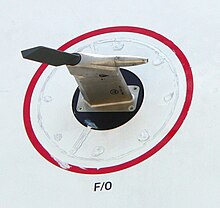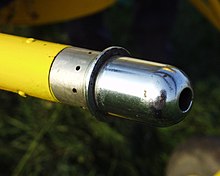
Back Pitotbuis Afrikaans أنبوب بيتو Arabic Pito Borusu Azerbaijani Pitotova cijev BS Tub de Pitot Catalan Pitotova trubice Czech Pitotrør Danish Pitotrohr German Pitottubo Esperanto Tubo de Pitot Spanish






A pitot tube (/ˈpiːtoʊ/ PEE-toh; also pitot probe) measures fluid flow velocity. It was invented by a French engineer, Henri Pitot, in the early 18th century,[1] and was modified to its modern form in the mid-19th century by a French scientist, Henry Darcy.[2] It is widely used to determine the airspeed of aircraft;[3] the water speed of boats; and the flow velocity of liquids, air, and gases in industry.
- ^ Pitot, Henri (1732). "Description d'une machine pour mesurer la vitesse des eaux courantes et le sillage des vaisseaux" (PDF). Histoire de l'Académie Royale des Sciences avec les mémoires de mathématique et de physique tirés des registres de cette Académie: 363–376. Retrieved 2009-06-19.
- ^ Darcy, Henry (1858). "Note relative à quelques modifications à introduire dans le tube de Pitot" (PDF). Annales des Ponts et Chaussées: 351–359. Retrieved 2009-07-31.
- ^ Venturi effect and Pitot tubes | Fluids | Physics | Khan Academy, September 2014, retrieved 2019-12-15
© MMXXIII Rich X Search. We shall prevail. All rights reserved. Rich X Search